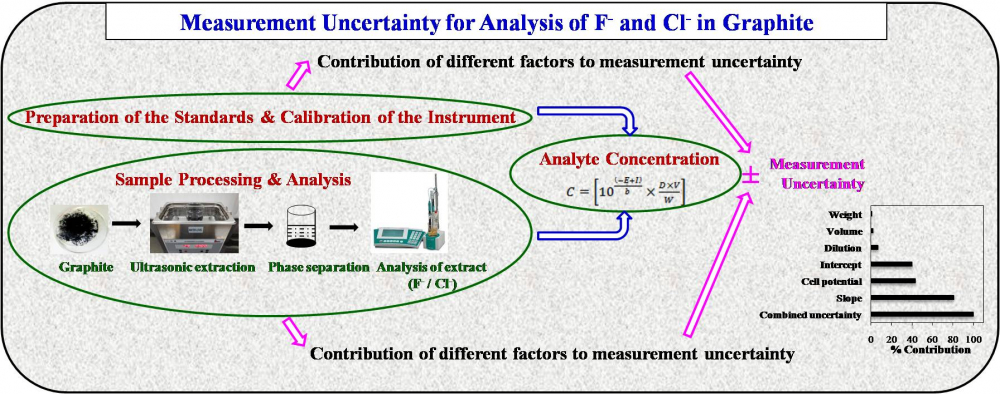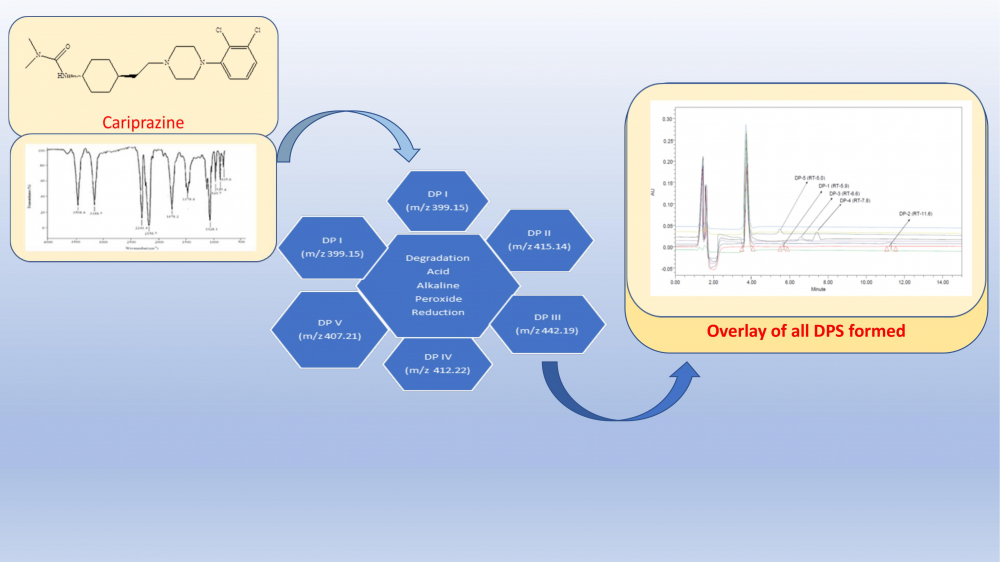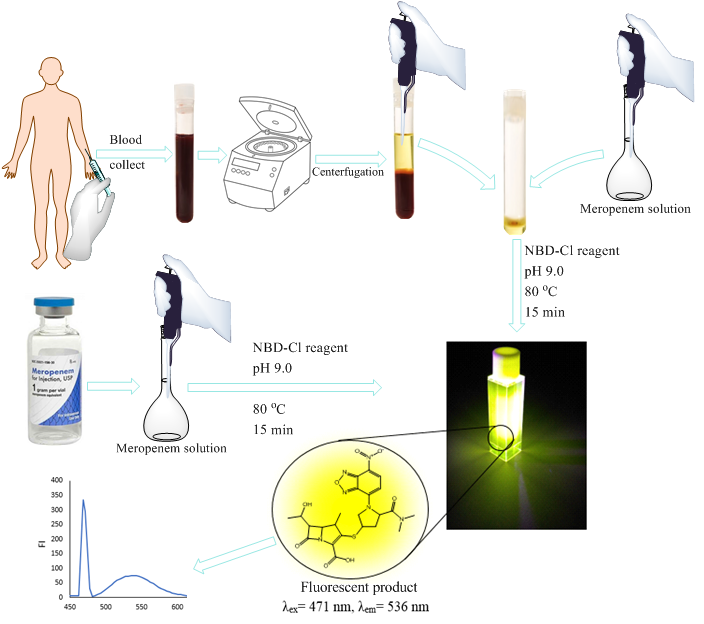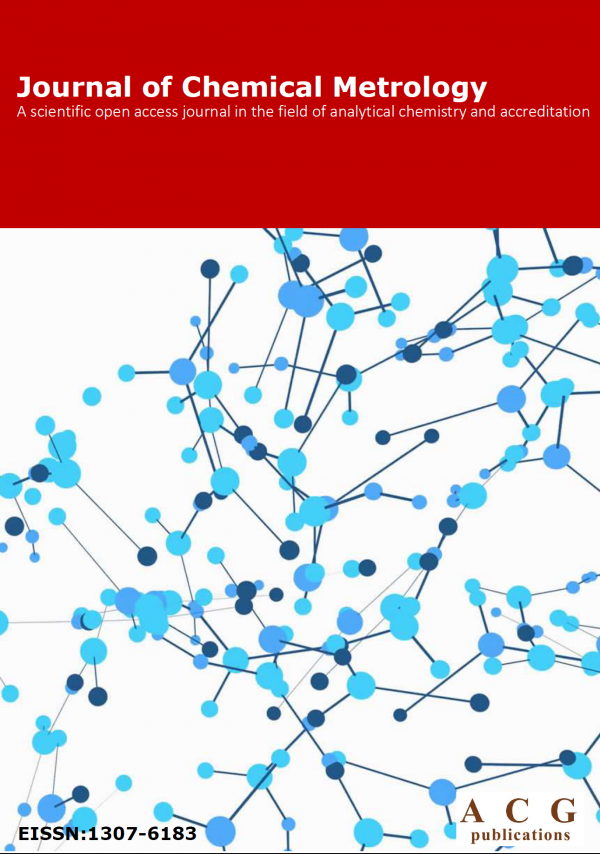Journal of Chemical Metrology
Year: 2022 Volume: 16 Issue:1 January-June
1) Measurement uncertainty assessment for potentiometric determination of trace anionic impurities in graphite post ultrasonic extraction: A bottom-up approach

An evaluation of measurement uncertainty in the analysis of trace level fluoride (F−) and chloride (Cl−) impurities in the refractory matrix (graphite) using a bottom-up approach based on the EURACHEM CITAC guide is presented herein. The major uncertainty contribution in the measurement was from calibration slope in case of F− and calibration intercept in case of Cl−. The expanded uncertainties calculated by considering the coverage factor (k= 2) was found to be 7.1 % for F− and 3.9 % for Cl−. The higher uncertainty in case of F− in comparison with Cl− could be attributed to the presence of F− in the limiting concentration range. The impact of calibration intercept in the measurement uncertainty for Cl− analysis can be attributed to the significant contribution of the blank towards the electrode potential. The studies demonstrated the effect of analyte concentration on the measurement uncertainty. The content of analytes along with the expanded uncertainty in the graphite sample were reported as 17.2 ± 1.2 mg/kg of F− and 3300 ± 130 mg /kg of Cl− (calculated within 95% confidence level). The statistical concurrence of the results obtained from Ion Selective Electrode (ISE) and Ion chromatography (IC) analyses was confirmed by student’s t-test values.
DOI http://doi.org/10.25135/jcm.69.2202.2367 Keywords Measurement uncertainty fluoride (F-) chloride (Cl-) graphite ion selective electrode (ISE) ion chromatography DETAILS PDF OF ARTICLE © 2022 ACG Publications. All rights reserved.2) Identification, separation and mass spectral characterization of degradants in Cariprazine HCl by LC-MS/MS/QTOF

The Present work aims at the determination of degradation products by a developing an efficient method which was achieved by utilizing Waters C18 150x4.6mm, 3.35-micron column with flow rate of 1mL/min in an innovative, simple, and an accurate high-performance liquid chromatographic method. The mobile phase of methanol and 0.1% orthophosphoric acid in proportion of 50:50 (% v/v) ratio was employed at a wavelength of 216 nm. The recommended approach demonstrated good linearity in the Cariprazine HCl concentration range of 5 µg/mL to 75 µg/mL. Studies on precision and recovery have shown accuracy rates ranging from 98 to 102%. All robustness conditions have an RSD of less than 2%. Solvent stability is maintained over 24 hours even when subjected to high stress levels. According to ICH guidelines, method validation is performed, and the parameters investigated include precision and accuracy as well as specificity and stability along with robustness, linearity, the limit of detection and the limit of quantification as well as the limit of detection. The ultimate composition of degradation products was determined using Tandem Mass Spectrometry with Liquid Chromatography and all the degradant are formed at various stress conditions were successfully characterized and the possible pathways were demonstrated.
DOI http://doi.org/10.25135/jcm.68.2201.2338 Keywords Degradant ICH Guidelines LCMS RP-HPLC cariprazine HCl DETAILS PDF OF ARTICLE © 2022 ACG Publications. All rights reserved.3) Uncertainty estimation for total antioxidant capacity measurement of apple juice using main CUPRAC method

The estimation of uncertainty –taking into account all sources of error- is an important tool allowing the identification the influence of each stage of the analytical procedure on the overall quality of the results. Measurement uncertainty - reported with the measurement result - is a parameter that indicates the distribution of the probabilities attributable to the measurement results. The aim of this study is the first time estimation of measurement uncertainty for total antioxidant capacity (TAC) of a Turkish commercial apple juice by the main CUPRAC method that uses Cu(II)-neocuproine (Nc)/Cu(I)-Nc redox couple to measure the TAC levels of various biological fluids and foods. The individual source of uncertainties such as repeatability, calibration curve, concentration of the trolox (TR, reference) solutions, pH, temperature and redox factor in the CUPRAC reaction between TR and Cu(II)-Nc were considered in this work. It was found that the measurement uncertainty was dominantly affected by the total CTR standard solution (ur(CTR) =0.0124). Each uncertainty parameter was evaluated separately, and the relative expanded uncertainty value was calculated as ±3.05% with a 95% confidence interval (k=2).
DOI http://doi.org/10.25135/jcm.67.2201.2311 Keywords Apple juice total antioxidant capacity original CUPRAC method measurement uncertainty bottom-up approach DETAILS PDF OF ARTICLE © 2022 ACG Publications. All rights reserved.4) Development of RP-HPLC PDA method for concurrent quantification of Baloxavir marboxil and its impurities

For the quantification of contaminants in Baloxavir marboxil (BXML), a simple and accurate RP-HPLC method was established and validated. BXML is an antiviral agent used to treat infections caused by influenza A and B viruses. To achieve optimal separation of all five impurities along with main moiety BXML the chromatography was carried out with X-Bridge Phenyl (150 x 4.6 mm) 3.5µ column with a mobile phase flow speed of 0.5 mL/minute. The mobile phase comprised of methanol and KH2PO4 buffer (pH 2.5) in gradient mode. The retention periods of Imp - 1, Imp - 2, Baloxavir marboxil, Imp - 3, Imp - 4 and Imp - 5 were found to be 1.919, 3.264, 4.429, 7.053, 8.247 and 8.937 min respectively. The developed method was found to be specific and linear (R2 > 0.999) for quantification of the target analytes. LOD was established as 0.020, 0.002, 0.001, 0.005, 0.002 and 0.002 µg/mL for BXML, Impurities 1, 2, 3, 4 and 5 respectively. Similarly, the LOQ was established as 0.066, 0.006, 0.003, 0.016, 0.006 and 0.006 µg/mL for Baloxavir marboxil, its Impurities 1,2,3,4 and 5 respectively. The % recovery by the assay was determined within the range of 98 –102%.
DOI http://doi.org/10.25135/jcm.71.2202.2344 Keywords Baloxavir marboxil method development validation impurity RP-HPLC DETAILS PDF OF ARTICLE © 2022 ACG Publications. All rights reserved.5) A highly selective and sensitive spectrofluorometric method for quantification of meropenem in its dosage form and fresh human plasma

The present study aims to develop and validate a robust, fast, simple, and sensitive spectrofluorimetric approach for the estimation of meropenem (MRP) in its dosage form and fresh human plasma. The developed method is mainly depending on a nucleophilic substitution reaction of MRP with 4-Nitro-7-chlorobenzofurazan (NBD-Cl) in alkaline media (pH 9.0), which results in a strongly fluorescent yellow adduct measured at 536 nm when excited at 471 nm. The variables that influence the stability and development of reaction product were thoroughly investigated and optimized. Calibration curve is rectilinear within the range of 25-650 ng mL-1 of MRP with a linear correlation coefficient (r =0.9981). Quantification and detection limits were estimated to be 9.55 ng mL-1 and 3.15 ng mL-1 respectively. The presented approach was successfully used to the analysis of commercial meropenem vials and meropenem-containing fresh human plasma with good results.
DOI http://doi.org/10.25135/jcm.70.2202.2363 Keywords NBD-Cl meropenem human plasma spectrofluorimetrY DETAILS PDF OF ARTICLE © 2022 ACG Publications. All rights reserved.